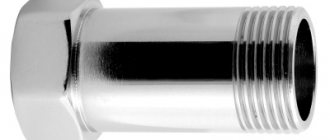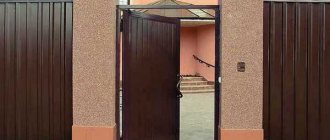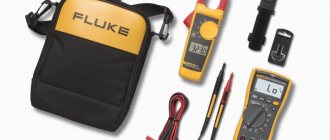Just a few decades ago, replacing plumbing required special precision, because it was important that the sewer outlet coincided exactly with the outlet. At the moment, the problem of selecting pipe radii has been solved thanks to a product such as toilet corrugation. A large number of advantages have led to its widespread use.
What is a toilet corrugation?
This name refers to a special type of pipe that acts as a transition element in the sewer system. The corrugation for connecting the toilet is made of polymer material, which simplifies installation. Its weight is light, which allows you to install it yourself and alone. To understand the popularity of a product, you need to know its advantages:
- Low cost compared to other plumbing parts.
- Easy to install, no professional skills or tools required.
- Installation speed – operation can be carried out almost immediately.
- Practicality due to the flexibility of the body.
- The versatility of the design allows it to be used in different device models.
- Reliability thanks to rubber seals.
The corrugation for the toilet also has negative aspects of the product:
- Low mechanical strength due to the design.
- Possibility of clogging if the product is not used correctly.
What does a toilet corrugation look like?
This name refers to a bend made of plastic and distinguished by its flexibility. In addition, an important indicator is the ability to stretch. They use products for installing various plumbing fixtures, selecting the appropriate pipe diameter. You need to know what parts the toilet corrugation consists of. A simple design includes several parts:
- cuff;
- corrugated pipe;
- seals.
Advantages and disadvantages
Corrugation (cuff) is a transitional element of the plumbing system, designed to connect the toilet to the sewer system. It is a fairly wide pipe with corrugated walls, made of modern thermoplastic.
The corrugated toilet connector allows you to connect plumbing to the sewer quickly and efficiently. The duration of its operation depends on proper installation
The edge is decorated with a cuff, which facilitates the process of connecting to the pipes and the toilet outlet. The design of the walls, which gave the name to this product, allows you to increase the size of the adapter to certain limits. Typically the sleeve length varies between 23-50 cm.
The diameter of the cuff that is attached to the toilet is 13.4 cm on the outside and 7.5 cm on the inside. The end that is installed on the sewer pipe usually has a hole with a diameter of 11 cm.
The main advantages of corrugation designed for toilets are low price and easy installation. This element is often used in cases where the diameter of the toilet outlet and the sewer pipe do not match. The corrugation is very convenient if the position of the toilet needs to be changed, moving it relative to the entrance to the sewer.
It is also often used as a temporary element, when during repairs the toilet is not yet fixed, but it needs to be used. However, corrugation cannot be called an ideal choice; it is not the most durable element. For example, if a piece of ceramic tile or a sharp piece of glass accidentally falls into the toilet, the corrugated joint can easily be damaged.
If the corrugation is located at too large an angle or incorrectly curved, blockages often occur in it, and an element that is too long sometimes sags under the influence of its contents. Corrugation should never be placed inside a wall; it is only suitable for open installation.
Types of corrugations for toilet bowls
There are different types of corrugated products on the market. To choose the right option, you should know what kind of corrugations there are for the toilet. Based on their rigidity, devices are divided into:
- soft;
- hard.
Depending on the type of coating, products are:
- unreinforced;
- reinforced with wire.
By size, toilet corrugations are divided into:
- short;
- long.
According to the direction of the bell, the products are:
- straight
– universal option; - curved at 90°
- for devices with direct release; - curved at 45°
- for connection to a horizontal socket.
- Manufacturer
. Almost all imported toilet corrugations are reinforced. - Hole size
. It is recommended to purchase the corrugation together with the plumbing fixture, which eliminates errors. - Rigidity
. This parameter is related to the material of manufacture. Plastic corrugations are softer and thinner. Reinforced pipes are rigid, but the thickness is the same. - Length
_ Here you need to focus on the distance between the drain and the plumbing. It is important not to stretch the pipe too much, as leakage may occur. - Reliability
. It is good if the corrugation for a toilet bowl with or without an outlet is equipped with reinforced wire, which will add rigidity and strength. - short corrugation for the toilet;
- long.
Dimensions of corrugations for toilet bowl
One of the important indicators when choosing is the length of the product. There are two categories:
Standard sizes that can be found on the market:
- length ranges from 230-500 mm;
- the cuff has a diameter of 135 mm;
- the size of the end connecting to the sewer socket is 100-110 mm;
- the diameter of the fastening nozzle is 50-70 mm.
Features of using a corrugated adapter
The cuff or corrugation for the toilet is not used to connect to the sewer in all cases. The fact is that plastic pipelines are more reliable and can last much longer.
But in some cases it is impossible to do without a corrugated adapter. For example, if the toilet cannot be mounted directly opposite the sewer outlet or when the floor level has risen higher after renovation. This happens when the old floor covering is not dismantled, but new tile material is laid on top of it.
Sometimes the location of the toilet is changed due to the rearrangement of plumbing equipment, if it is necessary to install, for example, a shower stall. Corrugation is used when the type of outlet of the mounted device does not correspond to the existing sewage system.
People living in Soviet-built houses often face a similar problem. In them, old sewer networks are designed to connect to devices with an oblique outlet, while in modern toilets it is made straight.
How to shorten the corrugation for a toilet bowl?
If there is no need, then it is better not to violate the integrity of the product, because leaks may occur due to future load. However, sometimes situations arise when this cannot be avoided. Straight and corner corrugation for a toilet bowl is shortened as follows:
- carefully cut off the accordion from the pipe;
- remove excess length;
- the end is installed back, running sealant along the seam;
- give time to dry;
- check the quality of joints.
Tighten loose bolts
Another reason when a toilet leaks at the junction is the loosening of the tank mounting bolts. They are usually metal or plastic. While the former can rust and break, the latter simply burst over time due to static load or if someone rests on the tank.
The problem is solved by replacing the bolts with new ones, and to do this you need to proceed as follows:
- turn off the water supply to the tank and empty it;
- unscrew the flexible supply hose;
- remove the bolts (if they are rusty, this will not be easy, but be careful not to damage the fragile tank);
- insert new bolts with spacers into the holes and tighten (just do not overdo it).
If it is still leaking at the joint, you will need to tighten the bolts a little more to seal the toilet. The main thing is not to squeeze it so that nothing bursts or cracks.
How to put corrugation on a toilet?
The installation process is simple if you follow the step-by-step instructions. Installation and replacement of the toilet bowl corrugation is carried out in the following order:
- Clean the toilet pipe, cover it with sealant and put the end of the corrugation with internal membranes on it. You need to make sure that everything is even and symmetrical.
- Give it time to dry.
- The edge of the toilet corrugation, which has external sealing rings, is connected to the pipe leading to the riser. It is important to insert it all the way. As with the other part, preliminary cleaning of debris and rust is carried out. For more reliable fixation, a sealant is additionally used.
- Leave for a while to dry completely.
- The installation of the corrugation on the toilet is completed by checking the quality of sealing of the joints. This is done by pouring a bucket of water into the toilet.
Sequence of actions during installation
The process of replacing a part on a toilet is not too long or complicated if you strictly follow the following rules:
- turn off the water supply to the toilet tank to flush;
- remove the tube that is responsible for the water supply;
- pour out the liquid from the toilet tank;
- remove the tank from its usual place;
- remove the old cast iron pipe that connected the toilet and drain;
- If the pipe is built into the floor, it will be more difficult to remove. You need to take a hammer and hit the drain hole on the sanitaryware. Don't hit with all your might, light taps are enough. The concrete must become mobile. This will make it easier to replace the corrugation on the toilet.
- It is strongly not recommended to hit a cast iron pipe with a hammer. This way you can split the cast iron into small pieces, the crack can also go to the toilet, then it will have to be replaced with a new one;
- wipe away the water that comes out of the old pipe after dismantling.
If you do break the earthenware, then sealing it with sealants makes no practical sense. Sooner or later, leaks will start anyway. It is more rational to install new plumbing.
After removing the old pipe, place plugs where the corrugation enters the drain and the outlet of the sanitaryware. Otherwise, the malicious smell of sewage will quickly spread throughout the apartment.
Did you remove the corrugation for the toilet, but did not put plugs on the riser and the outlet of the sanitaryware? The appearance of a malicious sewer smell is guaranteed
In order to change the corrugation on the toilet to a new one, prepare the following tools:
- sledgehammer;
- roulette;
- sealant or “liquid nails”;
- tape made of fluoroplastic sealing material (FUM);
- drain hose for sanitaryware;
- adjustable wrenches.
The algorithm for how to put corrugation on earthenware looks like this:
- do not proceed with fastening without trying it on, attach the tube to the plumbing fixtures: do the holes match in diameter, does the length of the product correspond to the required values;
- if you need to shorten the corrugation for the toilet, first take measurements using a tape measure, then cut off the excess using a sharp knife;
- Make a marking with a construction marker - where to attach the element on the toilet, on the riser;
- The corrugated pipe, riser and sanitaryware are connected to each other with dowels (screws). If there are no holes for them, drill them;
- the corrugated tube must be clean, free from dust and dirt, first clean it and dry it;
- Treat both ends with waterproof sealant or “liquid nails”;
- There should be no gaps under any circumstances, otherwise liquid will leak out; cover all holes with sealant or “liquid nails”;
- check the functionality of the assembled structure. If there are no leaks or blockages, everything is done correctly!
How to seal a toilet bowl?
To get rid of voids, a silicone compound is used. This is done at the installation stage, the sealant is distributed in a thin strip over the seam, and then smeared over the surface. Installing the corrugation on the toilet with your own hands allows you to use the plumbing after just a few hours. When using quality products during the installation phase, reapplying sealant is more of a precaution than a mandatory process.
Sealant for toilet bowl corrugation
Among the range offered on the market, the following types are used for installing corrugations on a toilet:
- Silicone
. The most popular option, which has high resistance to humidity and temperature changes. It can be used for both external and internal application. For example, Ravak Professional and Ceresit Sanitary CS 15. - Polyurethane
. Elastic adhesive composition, characterized by strength, durability and wear resistance. Due to toxicity, it is recommended for outdoor use only. For example, Molder PU and PU 39 Bostik.
When figuring out how to lubricate the corrugation between the toilet and the pipe, we note that professionals recommend using silicone sealant. Popularity was achieved due to the following advantages of the composition:
- resistance to UV rays;
- suitability for working with all materials;
- resistance to temperature changes;
- creating protection against the appearance of fungus;
- high strength;
- resistance to household chemicals;
- environmental cleanliness.
Advantages and disadvantages
To install a toilet corrugation, you should know the technology for performing such work and take into account some important nuances. This product is a transition element, which is intended to connect a plumbing fixture to a sewer system. It has the shape of a wide pipe with corrugated walls and is made from modern material - thermoplastic.
The edge of the corrugation for plumbing is decorated with a cuff, which facilitates the work of connecting the pipeline and the toilet outlet. The structural feature of the walls, which gives the name to this product, allows you to increase the parameters of the adapter to a certain limit. Sleeve length usually ranges from 23 to 50 centimeters.
The diameter of the toilet corrugation, or rather the cuff attached to the device, is 13.4 centimeters on the outside, and 7.5 centimeters on the inside. The end installed on the sewer pipe usually has a hole of 11 cm in diameter.
The main advantages that this element has are ease of installation and affordable cost. It is usually used in cases where the sizes of the corrugation for the toilet bowl and the pipe discharging waste do not match. This product is very convenient to use if there is a need to change the position of a plumbing fixture by moving it relative to the entry point into the wastewater disposal system.
Corrugation is also used as a temporary element when, during repairs, the toilet is not yet completely fixed, but it needs to be used. But this product cannot be called the best choice of material, since it is not durable.
For example, if a sharp piece of glass or a piece of ceramic tile accidentally falls into the toilet, a corrugated connection will be easily damaged. If the element is bent incorrectly, blockages will begin to collect in the adapter, and if the length of the toilet corrugation is too long, it will sag under the weight of the contents. It is not placed inside walls, as it is only suitable for outdoor installation.
How to hide the corrugation from the toilet?
The choice of masking method depends on the size and direction of the pipelines, their location relative to each other, the presence of additional devices, and so on. After connecting the toilet to the sewer with corrugation, use one of the following methods for hiding the pipes:
- Box made of plastic panels
. A base is created from profiles onto which the plastic is attached. This method can be used when this material is present in the interior. - A plasterboard box on a frame
. The blank is made of wood, with water-repellent plasterboard attached on top. Finally, decoration is carried out with the material that covers the walls of the toilet. - Built-in sanitary cabinet
. It is a structure on the wall behind the toilet with doors. - Blinds or roller shutters
. Installed in the same way as a built-in wardrobe.
Hiding sewer lines in the toilet
Preparatory work
Ways to hide pipes in the toilet
What is better to choose
Plumbing communications are unlikely to decorate the interior, so many during renovations wondered how to close the pipes in the toilet. We offer several ways to preserve the beauty of the room and not lose access to the water supply structure.
How to clean the corrugation of a toilet bowl?
There are situations when the sewer becomes clogged, which is especially true for old buildings. Clogs form due to the accumulation of hair, dirt, grease, or insoluble detergents. Flexible and rigid toilet corrugation is cleaned in the following ways:
- Plunger
. It is installed as close as possible to the drain and pressed several times. A plunger can easily remove a small blockage. - A folk remedy is a mixture of soda and vinegar
. Proportion 1:1. Pour in the dry ingredient, then pour it in and give it a few minutes to react. Finally, use a plunger. - Chemicals for cleaning drains
. The product is poured inside, as described in the instructions on the package. The process takes up to 5 hours. - The resulting fossils are removed using a metal cable
. It is placed in a pipe and begins to rotate, moving deeper. - Remove the corrugation
. Shut off the water, place a deep container under the pipe, remove everything and clean it mechanically.
Why is the toilet bowl dripping?
Sometimes situations arise when all the work was carried out at a high level, but problems with leakage are still present. The reasons why the toilet bowl drips may be as follows:
- The product is of questionable quality and does not adhere well to the pipe, forming unwanted folds.
- The skirt at the cuff is not straight, but cone-shaped. This is a problem that can only be corrected by replacing the corrugation.
The toilet bowl is leaking - what to do?
When plumbing malfunctions, it becomes the source of a large number of problems. To prevent the smell of sewage that leaks from being absorbed into the floor surface, you need to know what to do if the toilet bowl leaks. Before starting repairs, an inspection is carried out to identify the problem and only then a decision is made on how to correct the situation. The causes of leakage may be the following situations:
- pipe rupture;
- poor sealing of joints.
The corrugation for the toilet bowl is repaired according to the following scheme:
- The crack is dried and covered with a rubber patch. To do this, use only waterproof glue.
- You can soak a bandage in a cement mixture and wrap it around the pipe.
- The loose fabric is treated with sanitary silicone and placed on the toilet outlet.
Varieties
Corrugated connection systems differ in the raw materials from which they are made, as well as in the method of fastening. For example, for the owner of a small room, the best option would be a pipe with an outlet that will allow you to connect two parts to one passage of the structure at once. When installing a corrugation of this kind, a special rubber cuff may also be useful.
The corrugation of modern European manufacturers is mostly assembled from a reinforced base. It is strengthened with a special flexible metal wire. This model is rigid, its structure does not sag and resists aggressive external influences.
Pipes made from polypropylene raw materials are very soft. Their rubber base is extremely flexible. These corrugations are popular when installing temporary toilets at fairs or other public events.
Corner corrugation with outlet is used in cases where the sewer system is located too close to the mounting area with the toilet. Its main function is to provide a strong bending connection. During installation, you may need a toilet eccentric to ensure a good seal. The element consists of two cylindrical containers, one of which is located as close as possible to the instrument outlet, and the other to the sewer pipe.
It is worth considering that currently the only possible alternative option for corrugation is a pipe with an angular outlet made of plastic. When installing it, a rubber cuff and sealing serum are used to seal the joints. Here, pipe parts and drainage systems also require the presence of special sockets.
A rigid pipe is stronger and looks more aesthetically pleasing. However, its main disadvantages are its bulkiness and the fact that when replacing just one pipe, it is necessary to dismantle the entire system. Vertical rigid models are installed quite rarely, and if this happens, it is only in private homes. The reason for this is the need to completely open the floor when dismantling or other repair work of the sewer system.
How to disconnect the corrugation from the toilet?
Despite the durability of the product stated by the manufacturers, there are cases when the corrugation for the toilet flush requires removal. There are different ways to remove it:
- Maximum stretched
. Remove it from the toilet pipe, and then from the sewer pipe. This sequence helps to easily remove remaining water. - Corner location
. Use the arc rule. Disconnection is carried out as in the previous method. - Maximum contracted state
. In this case, you will need to remove the toilet initially. Then the corrugation is disconnected, as in the previous versions.
Installation Quality Check
The first sign of incorrect installation is the appearance of a leak under the corrugated pipe. You can determine the location of the leak using toilet paper. Before this, you need to wipe the corrugation dry and, at the time of draining the water, apply toilet paper to different parts of the pipe. A wet spot will appear on the paper at the point of depressurization.
Other ways to check installation:
- Tilt angle control. The optimal value is 30°. An error of 10-15% is allowed.
- No sagging. This may cause waste to accumulate at the bottom of the pipeline.
- Drain control. During descent, the water should drain quickly, there should be no extraneous sounds or gurgling. The latter indicates a blockage or air lock.
When flushing, the corrugated toilet pipe should not vibrate. This indicates excessive tension or sagging. The consequences of this are that the fastening cuffs may come off.











